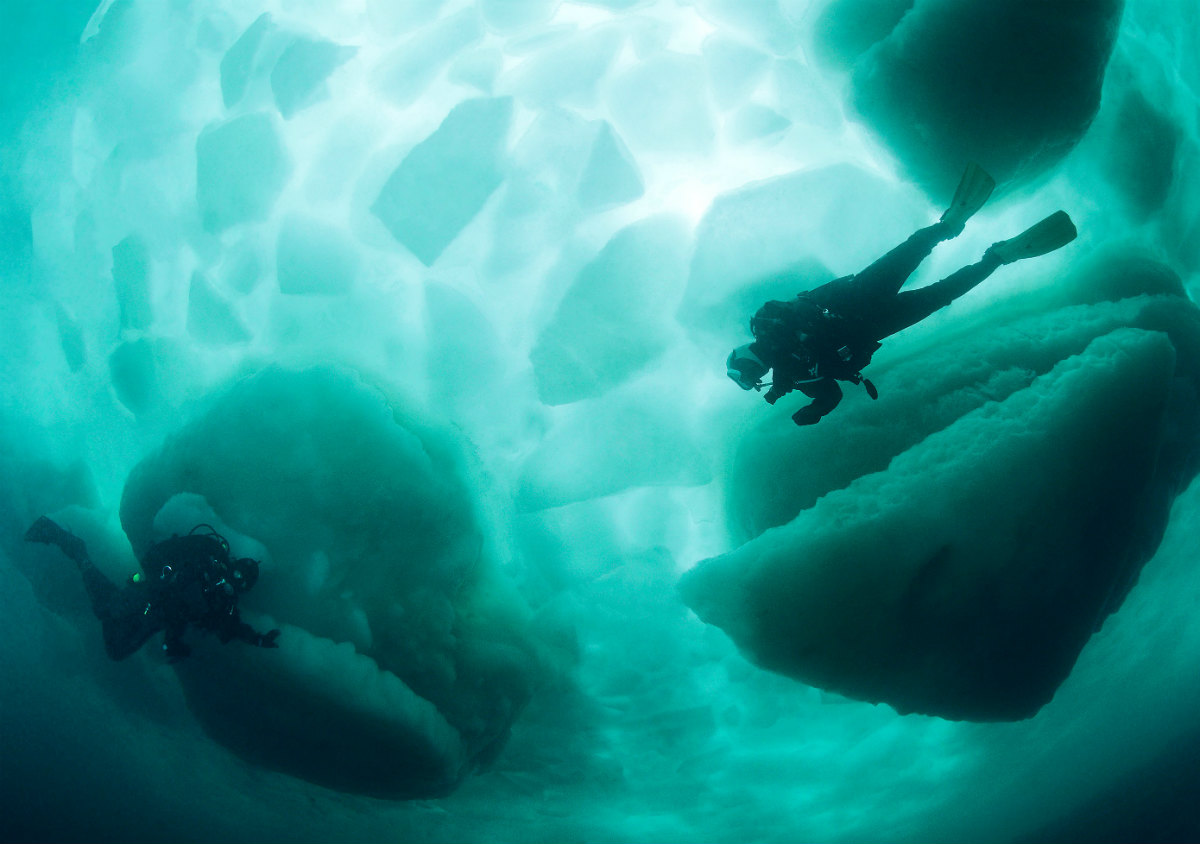
Canon EOS-1D X Mark II, f/9, 1/250s, ISO 800
Drift ice in the Arctic Circle can be seen in Hokkaido in the winter months.
Every year, for no more than three weeks, drift ice gathers in Shiretoko National Park in Hokkaido, Japan, to make ice diving possible. And under them, sea angels can be found. These tiny swimming sea slugs live at a depth of 200 metres in the Sea of Okhotsk from spring to autumn. In winter, they migrate with the drift ice to the coasts of Hokkaido.
I had always wanted an image of a sea angel shot in the wild that is also sharp enough to show its swimming muscle tissues. Using my trusty Canon EOS-1D X Mark II with a camera housing, I succeeded in achieving my dream – but not without overcoming the toughest of challenges.
Ice diving isn’t for the faint-hearted: It takes a good dry suit and layered undergarments to keep you warm. An experienced support team will help you with your dive gear, as well as getting in and out of the pre-cut holes in the ice. Even then, be prepared for frostbitten lips and perpetually painful fingers despite your thick gloves. Operating camera and strobe controls isn’t easy when wearing gloves either – and in such icy conditions, your brain is also barely capable of functioning – so my exposure settings were calculated guesses before entering the water to avoid having to fumble with buttons and knobs too much during the dives.
See also: Dealing with cold weather photography
The harsh temperatures also test your imaging gear to its limits. I’ve heard stories of dead batteries when the temperature gets below freezing point, and strobes taking forever to recharge – or simply refusing to do so – after firing a shot. Although my strobes seemed a little sluggish, and my supposedly fully charged dive torch gave me a low battery signal as soon as it was switched on, my Canon EOS-1D X Mark II experienced no problems in the freezing conditions.

Canon EOS-1D X Mark II, f/11, 1/250s, ISO 640
Contrary to its common name, the pelagic Sea Angel (Clione limacina) is a ferocious feeder.
To capture these sea angels with their flapping “wings” spreading out perfectly, I shot at the camera’s highest continuous shutter speed of 14 frames per second. Pushing the ISO hard allowed the strobes to fire at a power low enough to reduce batteries recycle time to keep up with the shutter releases. I did the mistake of using an unfamiliar rented BCD. Not able to find the dump valve, it was very difficult to control my buoyancy. I found myself alternating between sinking to the sand bottom and ascending until my head hit the ice layers above. Between these uncontrollable vertical movements, the fast autofocus of my Canon EOS-1D X Mark II – through a prime Canon EF 100mm f/2.8 Macro USM Lens, with the added challenge of a mounted powerful close-up lens– I managed to lock onto the miniscule, transparent sea angels with relative ease.

Canon EOS-1D X Mark II, f/11, 1/320s, ISO 50
Flabellina Athadona is a cold-water nudibranch.
When shooting wide-angle, things started out well with sunny blue skies and clear water. But by the time I got into the water myself, the sun had disappeared behind thick clouds and the substrate churned up by other divers. I cranked up the ISO and placed my strobes facing slightly outwards to cut down on backscatter. But in the turbid water, the flash didn’t reach far even at full power. Fortunately, the Canon EOS-1D X Mark II’s 20.2MP full-frame sensor captures an amazing amount of information in its RAW files, and in the comfort of my hotel room after a nice hot onsen bath later that day, I was able to recover superb detail in the shadowed areas of the image during post-processing.
Even in the most testing conditions, my Canon EOS-1D X Mark II came through with flying colours again, making it possible to produce tack sharp, perfectly exposed images of some of the ocean’s most fascinating and enigmatic subjects.
See also: EOS-1D X Mark II – In-camera Lens Optimization for High Quality Images
EOS-1D X Mark II Review (2): Testing the Image Quality with 4 L-series Lenses


































